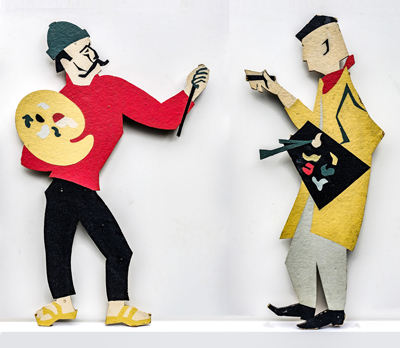Art Essay: The Woodstock School of Art 50-Year Celebratory Exhibition: “Founders: 1968”
By Raymond J. Steiner
arttimesjournal.com September 24, 2018
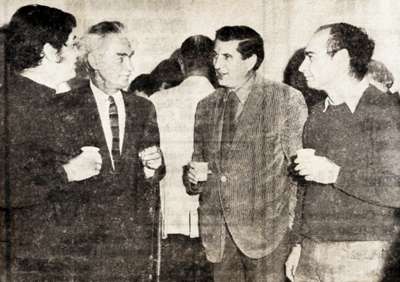 1968 photo of Founders of the Woodstock School of Art (L to R) Lon Clark, Wallace J. Jerominek, Robert Angeloch, Franklin Alexander |
IN COLLABORATION WITH the HISTORICAL SOCIETY OF WOODSTOCK, The WOODSTOCK SCHOOL OF ART is presenting a long look back at the burgeoning phenomena of the Woodstock, NY, artscene. Although the Hudson River “School” of landscape painters had been making inroads into the Hudson River/Catskill Mountain Region since the mid-1900s, the plein-aire ‘hotspot” in America would soon become the little hamlet of Woodstock, New York, as the major focal point for outdoor painting in the U.S. Made “famous” world-wide as the “hottest go-to” place for creatives of all stripes first by Ralph Radcliffe Whitehead’s “Byrdcliffe Art Colony” for artists and artisans, then the Art Student’s League of New York’s presence (League instructor Birge Harrison was already calling it “the best landscape school in the world”), soon followed by Hervey White’s bohemian haven, “The Maverick” which attracted actors, musicians and theatre-goers along with more artists, and then Bolton Brown’s “Rock City Road” breakaway group from Byrdcliffe, setting up what they called the “first” art colony in town and attracting “modernists” from all corners of the art world, augmented with the fast-growing Woodstock Artist’s Association (begun in 1919) acting as the binding element that brought all the groups “under one roof”, so to speak, even sponsoring 3 National art conferences in town…all making the town of Woodstock ‘sing’ to the world. The Woodstock artistic spirit, in fact, is so infectious that local businesses, banks, and even the synagogue of the Woodstock Jewish congregation hold ongoing artshows and exhibitions throughout the year; indeed, that spirit certainly inspired Cornelia Seckel and me to co-found ART TIMES in 1984. Woodstock, like most of America, had its ups and downs during the depression years and the boom after the end of WWII, but the town perked up once again when the League, after closing its doors during the lean years of the depression, began summer classes once again in 1947 to accommodate the sudden influx of students, especially the newly discharged servicemen who had schooling readily opened to them by the G.I. Bill. In conjunction with the US Government, the League had produced a movie, “How to Become an Artist”, extolling art classes as a viable career-opener for the home-coming veterans, advertising both their New York facilities and Woodstock summer classes as excellent starting-points with a young man named Robert Angeloch ‘starring’ as the main actor “David Boucher”……. the same Robert Angeloch (himself a WWII veteran of the U.S Air Corps), along with Franklin Alexander, Lon Clark and Wallace J. Jerominick who, in 1968, breathed yet more new life into town by founding the Woodstock School of Art.
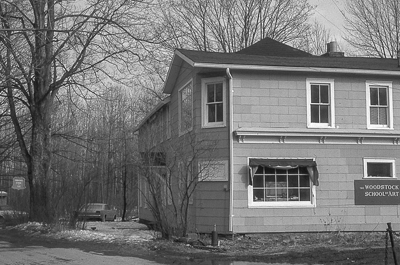 Woodstock School of Art 1968, 29 Millstream Rd. |
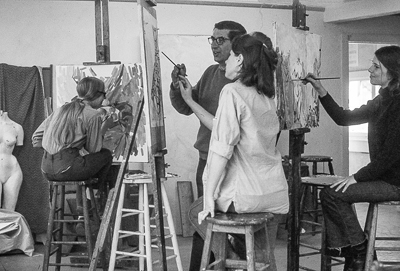 Robert Angeloch teaching at Millstream Rd. |
In spite of its “humble” beginnings in abandoned sheds and private studios of a few Woodstock artists, the WSA was destined to become a “rising star” with its own impact in a seemingly ever-blooming “art colony” that kept (and keeps) attracting yet other artistic organizations — the Byrdcliffe Guild (1902), the Woodstock Play House (1938), Performing Arts of Woodstock (1964), the Center for Photography (1970), various Art Galleries and coteries, for instance. Meanwhile, as far back as 1929, as these various organizations were noisily elbowing for space and recognition in the colony, a group of artists, writers, academics and community-minded Woodstockers quietly got together in the background to found the Historical Society of Woodstock, which set as its mission the keeping track and record of the town’s mushrooming growth as a cultural center. As joint collaborator and contributor to this current exhibition abundantly shows, the Society fulfilled its goal in noting, collecting and recording memorabilia, artifacts, documents and art, tracking and celebrating Woodstock’s growth as a celebrated, world-renowned art colony. Visitors and scholars are always welcome to visit the Society at its historical Eames’ House on Comeau Drive in the town’s center to view its extensive collection of art, documents and artifacts. As this present collaboration with the Woodstock School of Art demonstrates, the Historical Society of Woodstock (845) 679-2256 makes its resources available for research, exhibitions, and other public programming.
The Woodstock School of Art patterned itself after the Art Students League of New York’s ‘open’ policy of running an art school ‘atelier-style’ with no entry requirements or academic curricula governing its primary purpose of simply giving art instruction — eventually moving into the very same building (built during FDR’s “New Deal” program) which the League permanently vacated in 1979. A year later, 1980, the Woodstock School of Art incorporated, quickly gaining support and recognition not only by the New York State Council of the Arts but also by Governor Mario Cuomo’s New York State Legislature. Now located on 38 acres of prime Catskill Mountain/Hudson River landscape at 2470 Route 212 just outside of Woodstock, classes and workshops, taught, held, conducted in an extremely well-appointed and heated buildings and run by a staff of talented art-savvy people who almost yearly attract over 400 students, any artistic newcomer to town seeking artistic purpose or activity would quickly find a ‘home’ and a niche in this vibrant potpourri of artistic talent.
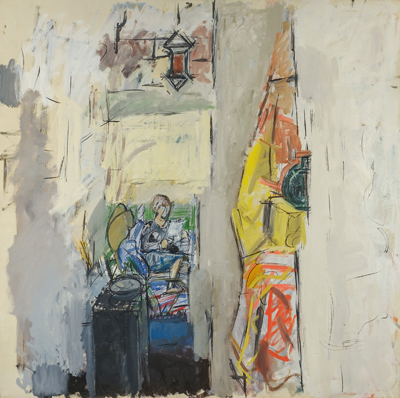 Mara Reading, oil 40x30 Lon Clark |
|
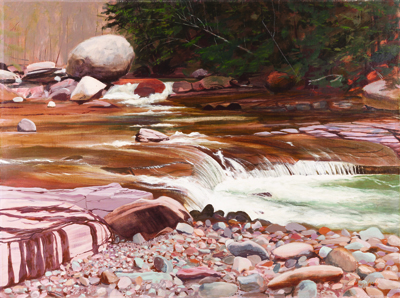 Stream at Shady, oil 30x40 Robert Angeloch |
|
On October 13, The Woodstock School of Art will open its doors and celebrate their unique impact* by sharing with the public an exhibition of the work by its founders while the Historical Society of Woodstock will display Woodstock memorabilia that will bring back to life an overview of the times and riches of this most extraordinary town and its people. Mark your calendars…you do not want to miss this one!
* Full disclosure: My own biases may be in play here since over the years I have had several interconnections with the WSA, profiling founders Robert Angeloch in the March 3, 1984 issue of theKingston Daily Freeman and writing the Introductions to both his Feld-Am-See booklet of etchings & prints as well as to the catalog of Franklin Alexander’s Major Exhibit at the Woodstock School of Art in September 2009; also, though never a student, I have previously written about numerous instructors and sat in several classes, even posed as a model in the classes of the late Jean Wrolsen (profiled by me in the February 5th, 1984 issue of Lifestyle), former instructor at the Woodstock School of Art.
50-Year Celebratory Exhibition:
“Founders: 1968.” Oct. 13 thru Dec.17, Woodstock School of
Art, 2470 Route 212, Woodstock, NY.
(845-679-2388) Opening Reception: Saturday, October 13, 3-5 PM


